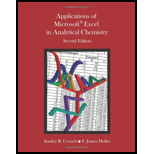
Applications of Microsoft Excel in Analytical Chemistry
2nd Edition
ISBN: 9781285629575
Author: Holler, F. James, Crouch, Stanley R.
Publisher: Cengage Learning
expand_more
expand_more
format_list_bulleted
Question
error_outline
This textbook solution is under construction.
Students have asked these similar questions
sketch the nature of the metal-alkylidene bonding interactions.
Part C
The perspective formula of isoleucine, an amino acid, is provided below.
HOOC
H₂NIC
H
川
CH3
CH,CH3
Draw the Newman projection in staggered conformation for isoleucine by viewing the molecule along the
C-2-C-3 bond.
1. Edit the Newman projection on the canvas.
2. Replace the appropriate hydrogens with the appropriate -CH3 or other groups.
3. If you need to start over, Undo or choose a Newman projection from the Templates toolbar
(bottom).
Important: Never delete the hydrogen atoms or bonds directly attached to the template, and do not move
them by dragging or dropping them. That will break the projections structures. Only replace them!
▸ View Available Hint(s)
0 2
H± 3D
EXP.
L
ד
י
CONT. 2
H
0
N
о
Can someone explain this?
Knowledge Booster
Similar questions
- 5. Drawn the structure of the compound (molecular formula C12H16) with the longest λmax in its UV-vis spectrum.arrow_forwardUse solubility rules to complete balance molecular equations, and provide total and net ionic equations.arrow_forwardUse solubility rules to provide balance molecular equation, total, and net ionic equationarrow_forward
- Use solubility rules to provide balance molecular equation, total, and net ionic equationarrow_forwardBr HO ? HO ✓ OHarrow_forwardUse the literature Ka value of the acetic acid, and the data below to answer these questions. Note: You will not use the experimental titration graphs to answer the questions that follow. Group #1: Buffer pH = 4.35 Group #2: Buffer pH = 4.70 Group #3: Buffer pH = 5.00 Group #4: Buffer pH = 5.30 Use the Henderson-Hasselbalch equation, the buffer pH provided and the literature pKa value of acetic acid to perform the following: a) calculate the ratios of [acetate]/[acetic acid] for each of the 4 groups buffer solutions above. b) using the calculated ratios, which group solution will provide the best optimal buffer (Hint: what [acetate]/[acetic acid] ratio value is expected for an optimal buffer?) c) explain your choicearrow_forward
- How would you prepare 1 liter of a 50 mM Phosphate buffer at pH 7.5 beginning with K3PO4 and 1 M HCl or 1 M NaOH? Please help and show calculations. Thank youarrow_forwardDraw the four most importantcontributing structures of the cation intermediate thatforms in the electrophilic chlorination of phenol,(C6H5OH) to form p-chlorophenol. Put a circle aroundthe best one. Can you please each step and also how you would approach a similar problem. Thank you!arrow_forwardA 100mM lactic acid/lactate buffer was found to have a lactate to lactic acid ratio of 2 and a pH of 4.2. What is the pKa of lactic acid? Can you please help show the calculations?arrow_forward
- Using line angle formulas, draw thestructures of and name four alkanes that have total of 7carbons, one of which is tertiary.Please explain this in detail and can you also explain how to approach a similar problem like this as well?arrow_forwardUsing dashed line wedge projections drawthe indicated compounds and indicate whether thecompound you have drawn is R or S.(a) The two enantiomers of 2-chlorobutane. Can you please explain your steps and how you would approach a similar problem. Thank you!arrow_forward5) There are no lone pairs shown in the structure below. Please add in all lone pairs and then give the hybridization scheme for the compound. (8) 10,11 7) 1.2.3 H 4 | 14 8) COC 12 13 H 16 15 H7 9) - 5.6 C 8 H 10) H 1). 2) 3)_ 11) 12) 13) 4)_ 14) 5) 15) 16) 6)arrow_forward
arrow_back_ios
SEE MORE QUESTIONS
arrow_forward_ios
Recommended textbooks for you
 Principles of Modern ChemistryChemistryISBN:9781305079113Author:David W. Oxtoby, H. Pat Gillis, Laurie J. ButlerPublisher:Cengage Learning
Principles of Modern ChemistryChemistryISBN:9781305079113Author:David W. Oxtoby, H. Pat Gillis, Laurie J. ButlerPublisher:Cengage Learning



Principles of Modern Chemistry
Chemistry
ISBN:9781305079113
Author:David W. Oxtoby, H. Pat Gillis, Laurie J. Butler
Publisher:Cengage Learning